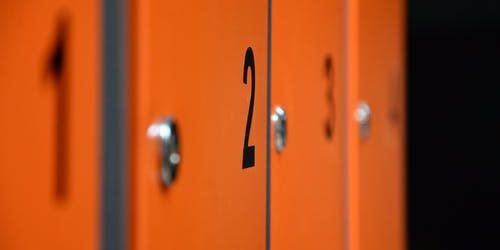How to remove locker doors
Lockers play an integral part in commercial settings such as offices, leisure centres, gyms and schools as they keep people’s personal belongings safe. It is therefore important to ensure that lockers are well maintained and secure at all times.
You may be looking to remove a locker door if it has been damaged and the frame remains stable. Here’s how to remove locker doors in three easy steps:
- Put on safety goggles
You should always take precautions and wear sufficient safety gear when using a powered hand drill.
- Drill through rivet head on the locker frame
Using a 3/16 inch drill bit, drill through the first rivet head on the locker’s metal frame. Take great care not to drill into the metal locker itself.
- Use a hammer and a metal punch to drive the remainder of the rivet through the locker shelf
- Continue to drill the rivets and drive them through the locker’s shelf
You will need to repeat this process until all the rivets are removed. At this stage, you should be able to remove the locker door itself.
Lockers can vary across brands and models, so, you may need to take a slightly different approach when removing locker doors. If this is the case, try and refer to your manufacturer’s instructions.
How do lockers work?
Lockers are mainly used to store belongings and are typically made from robust steel. How a locker works will depend on the locking system it features. Here are the main types of locker locks and how to operate them:
- Key locks – these simply require users to open them with a key that is easy to use and cheap to replace.
- Latch locks – users will attach a padlock to the latch to lock their belongings away and can either bring their own padlock or hire/buy one from the business. They are one of the most affordable options as well as easy to use.
- Mechanical combination locks – these require users to enter the correct combination for a locker in order for the locker door to open. They are ideal for saving money on replacement padlocks or keys but they rely on users remembering their code.
- Digital locks – these are digitally operated and usually just require users to press in the right combination but they will also rely on users remembering their codes.
- Smartcard locks – these are very easy to operate as users can simply tap a keyfob or smartcard on the contact point of the locker to open it.
- Coin lockers – these lockers require users to insert money into the locker before it can lock itself. You can find coin lockers that will return coins to users as well as ones that will deposit the money.
Types of lockers
There are lots of different lockers to cater for different uses and commercial environments, here at Manutan we can provide:
- Storage lockers – these are typically made from steel and are primarily used to store personal belongings in commercial environments such as schools and gyms.
- Cube lockers – these are also used to store personal belongings but are much smaller than standard lockers, making them space-efficient.
- Personal effects lockers – these are compact lockers designed for storing smaller personal items.
- Post lockers – these feature postal slots to store paperwork safely and are often found in offices and flats.
- Executive lockers – these will typically have additional features and designs such as wood finish doors to add to the aesthetic and theme of a building.
- Wire mesh lockers – As they are made from a wire mesh, these lockers are well ventilated and suitable for storing items such as PPE and bags.
- Antibacterial lockers – helps to promote good hygiene and prevent the spread of bacteria and odour as they have antibacterial doors and good ventilation systems.
- Plastic lockers – plastic lockers are great for wet environments which can cause rust to standard lockers. They are commonly found in outdoor environments or swimming pool areas.
- Laminate door lockers – these lockers feature a laminated finish which makes them more resistant to scratches and dents.
- Stainless steel lockers – these can easily be cleaned and resist rusting which makes them perfect for commercial environments such as hospitals where good hygiene is particularly important.
- Charging and laptop lockers – these allow users to store electronic devices such as laptops whilst charging them at the same time with inbuilt plug sockets. They are used in workplaces such as offices as well as festivals where there is limited access to charging points.
- Half-height lockers – as these lockers are smaller and more accessible, they are ideal for schools with young students.
- Perforated lockers – like antibacterial lockers, these feature great ventilation systems to control odours which makes them perfect for use in gyms and leisure centres.
- Clothes and workwear lockers – these larger lockers are ideal for staff who can store different items of clothing in the workplace and can feature coat rails, dividers and hat shelves for separate storage.
Need to fix a locker door?
Whether you have a faulty lock or a locker door that keeps getting jammed, you can read our blog on how to fix a locker.
Looking for lockers?
You could fix or replace locker doors yourself to save money, however, it may not always be possible. Moreover, you might wish to invest in new lockers which are more modern and secure.
If you’re looking to purchase new lockers, Manutan has got you covered! We have a wide range of lockers available, including storage lockers and post lockers to suit your individual business needs. Browse what’s in store today or contact our friendly team for more information.






